Yantrodharaka Hanuman Stotram with meaning, benefits (Sri Vyasaraja) (Sanskrit, Kannada, English) | Yantrodharaka Hanuman temple information (full)
Namaste friends, how are you doing today? Welcome to #BhagavanBhakthi website / blog.
Bhagavan Lord Sri Krishna (Vishnu, Rama, Narasimha, Trivikrama, Vamana), Goddess Rukmini (Satyabhama, Lakshmi, Sita, Dharini), Guru Sri Vyasaraja Tirtha and Guru Sri Raghavendra Swamy blessings to you and your family!
In this website / blog, you will always learn about #Hinduism #Sanskrit language.
Also subscribe to my YouTube channel from this link #BhagavanBhakthi to view videos about #Hinduism #Sanskrit language.
Just before going to “Yantrodharaka Hanuman Stotram with meaning, benefits (Sri Vyasaraja) (Sanskrit, Kannada, English) | Yantrodharaka Hanuman temple information (full)“, let us have some brief information.
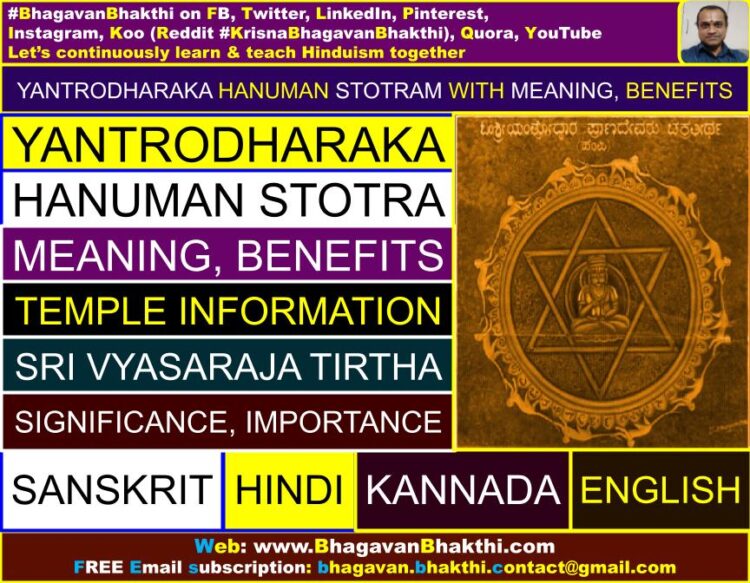
Sri Vyasaraja Guru, also known as Sri Vyāsatīrtha or Sri Chandrikacharyaru was born in 1460. He is famously known as Sri Chandrikacharya. He was a great Hindu Dvaita (All are unique) Vedanta philosopher, scholar and poet.
His contemporaries were great Sri Vadiraja Guru, Sri Purandara Dasa, Sri Kanaka Dasa. Few of the divine and great works of Sri Vyasaraja Guru are Nyayamruta, Tatparya Chandrika and Tarka Tandava collectively called Vyasa Traya.
Sri Vyasaraja Guru’s other avatars were 1st Shankukarna, 2nd Prahlada, 3rd Bahlika Raja, 4th Sri Vyasaraja Guru and 5th Sri Raghavendra Swamy.
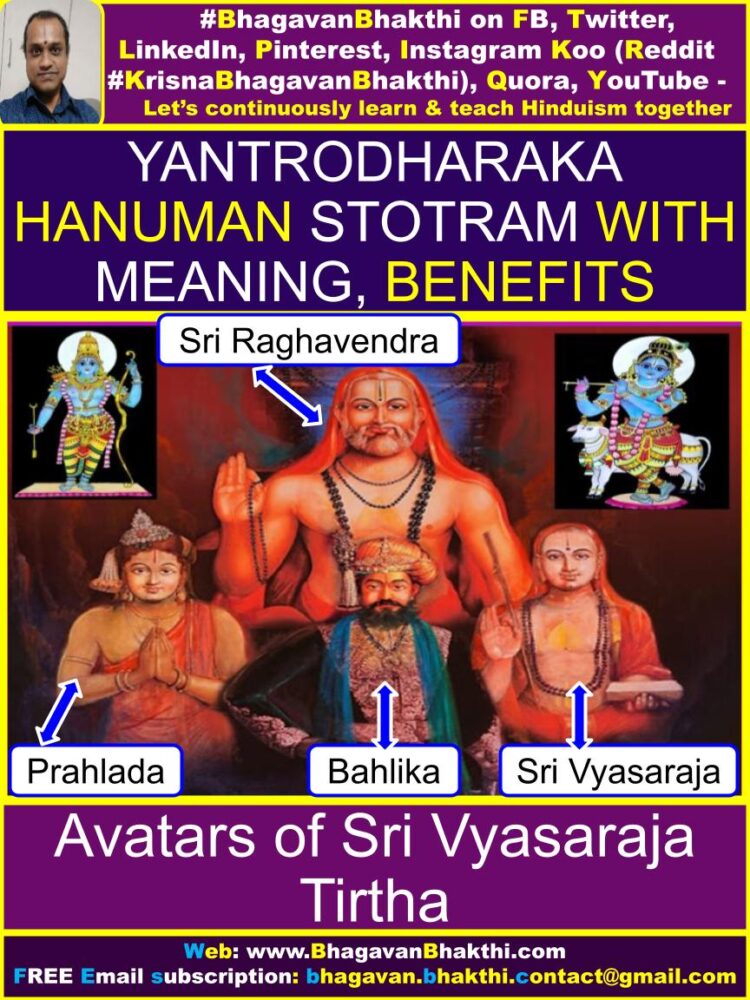
Hanuman Stotram (Stuti, Sloka) Yantrodharaka Hanuman Stotra (yantrōdhāraka hanumān sṭotraṁ) with meaning in Sanskrit (Hindi) is as given below:
नमामि दूतं रामस्य सुखदं च सूरदृवम् |
पीनवृत्त महाबाहुं सर्व शत्रु निवारणं || १ ||
नानारत्न समायुक्तं कुंडलादि विराजितं |
सर्वदाभिष्ठदातरं सतां वै दृढमावाहे || २ ||
वासिनं चक्र तीर्थस्य दक्षिणस्थ गिरौ सदा |
तुंगांबोधि तरंगस्य वातेन परिशोभिते || ३ ||
नानादेशगतै सद्भिः सेव्यंमानं नृपोत्तमैः |
धूपदीपादि नैवेद्यैः पंचखाद्य्यैश्च शक्तितः || ४ ||
भजामि श्री हहूमतं हेमकांति समप्रभम् |
व्यासतीर्थ यतींद्रेण पूजितं प्रणिधानतः || ५ ||
त्रिवारं यः पठेन्नित्यं स्तोत्रं भक्त्या द्विजोत्तमः |
वांछितं लभते भीष्टं षण्मासाभ्यांतरे खलु || ६ ||
पुत्रार्थी लभते पुत्रान् यशार्थी लभते यशः |
विद्यार्थी लभते विद्यां धनार्थी लभते धनं || ७ ||
सर्वथा मास्तु संदेहो हरिः साक्षी जगत्पतिः |
यःकरोत्यत्र संदेहं सयाती नरकं ध्रुवम् || ८ ||
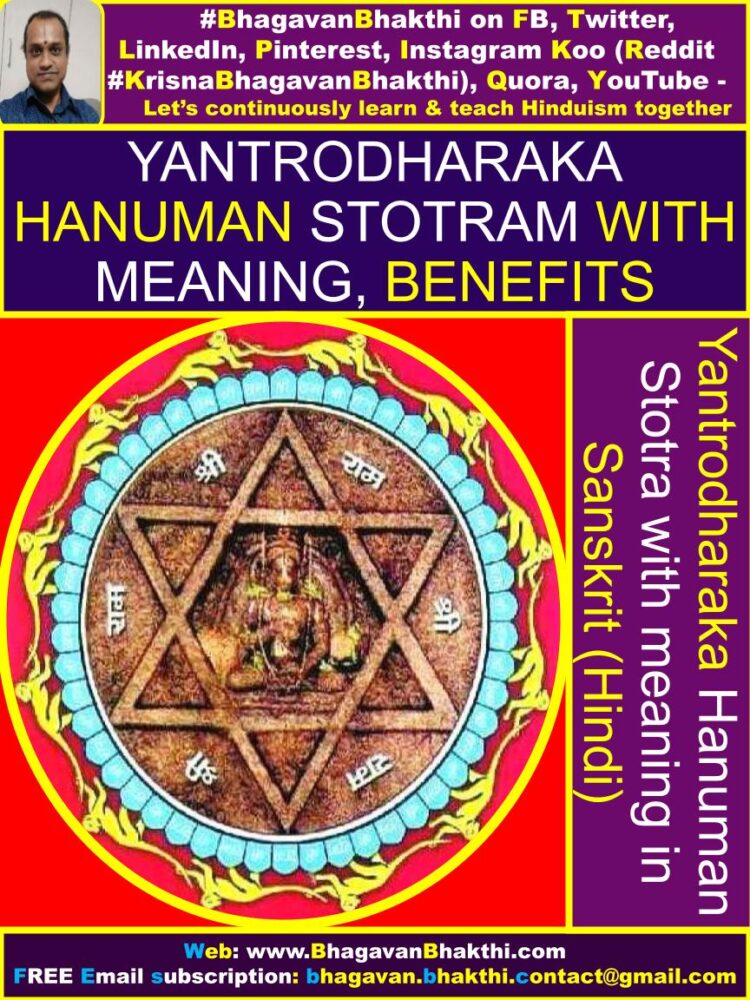
Hanuman Stotram (Stuti, Sloka) Yantrodharaka Hanuman Stotra (yantrōdhāraka hanumān sṭotraṁ) with meaning in Kannada is as given below:
ನಮಾಮಿ ದೂತಂ ರಾಮಸ್ಯ ಸುಖದಂ ಚ ಸುರದ್ರುಮಮ್ |
ಪೀನವೃತ್ತ ಮಹಾಬಾಹುಂ ಸರ್ವ ಶತೃ ನಿವಾರಣಂ ||೧||
ನಾನಾರತ್ನ ಸಮಾಯುಕ್ತಂ ಕುಂಡಲಾದಿ ವಿರಾಜಿತಮ್ |
ಸರ್ವದಾಭೀಷ್ಠದಾತರಾಂ ಸತಾಂ ವೈ ಧೃಢಮಾವಹೇ ||೨||
ವಾಸಿನಂ ಚಕ್ರ ತೀರ್ಥಸ್ಯ ದಕ್ಷಿಣಸ್ಥ ಗಿರೌಸದಾ |
ತುಂಗಾಂಬೋಧಿ ತರಂಗಸ್ಯ ವಾತೇನ ಪರಿಶೋಭಿತೇ ||೩||
ನಾನಾದೇಶಗತೈಃ ಸದ್ಭಿಃ ಸೇವ್ಯಮಾನಂ ನೃಪೋತ್ತಮೈಃ |
ಧೂಪದೀಪಾದಿ ನೈವೇದೈಃ ಪಂಚಖಾದ್ಯೈಶ್ಚಶಕ್ತಿತಃ ||೪||
ಭಜಾಮಿ ಶ್ರೀ ಹನೂಮತಂ ಹೇಮಕಾಂತಿ ಸಮಪ್ರಭಮ್ |
ವ್ಯಾಸತೀರ್ಥ ಯತೀಂದ್ರೇಣ ಪೂಜಿತಂ ಪ್ರಣಿಧಾನತಃ ||೫||
ತ್ರಿವಾರಂ ಯಃ ಪಠೇನ್ನಿತ್ಯಂ ಸ್ತೋತ್ರಂ ಭಕ್ತ್ಯಾ ದ್ವಿಜೋತ್ತಮಃ |
ವಾಂಛಿತಂ ಲಭತೇ ಭೀಷ್ಟಂ ಷಣ್ಮಾಸಾಭ್ಯಂತರೇ ಖಲು ||೬||
ಪುತ್ರಾರ್ಥಿ ಲಭತೇ ಪುತ್ರಾನ್ ಯಶಾರ್ಥಿ ಲಭತೇ ಯಶಃ |
ವಿದ್ಯಾರ್ಥಿ ಲಭತೇ ವಿದ್ಯಾಂ ಧನಾರ್ಥಿ ಲಭತೇ ಧನಂ ||೭||
ಸರ್ವಥಾ ಮಾಸ್ತು ಸಂದೇಹೋ ಹರಿಃ ಸಾಕ್ಷೀ ಜಗತ್ಪತಿಃ |
ಯಃಕರೋತ್ಯತ್ರ ಸಂದೇಹಂ ಸಯಾತಿ ನರಕಂ ಧೃವಮ್|| ೮||
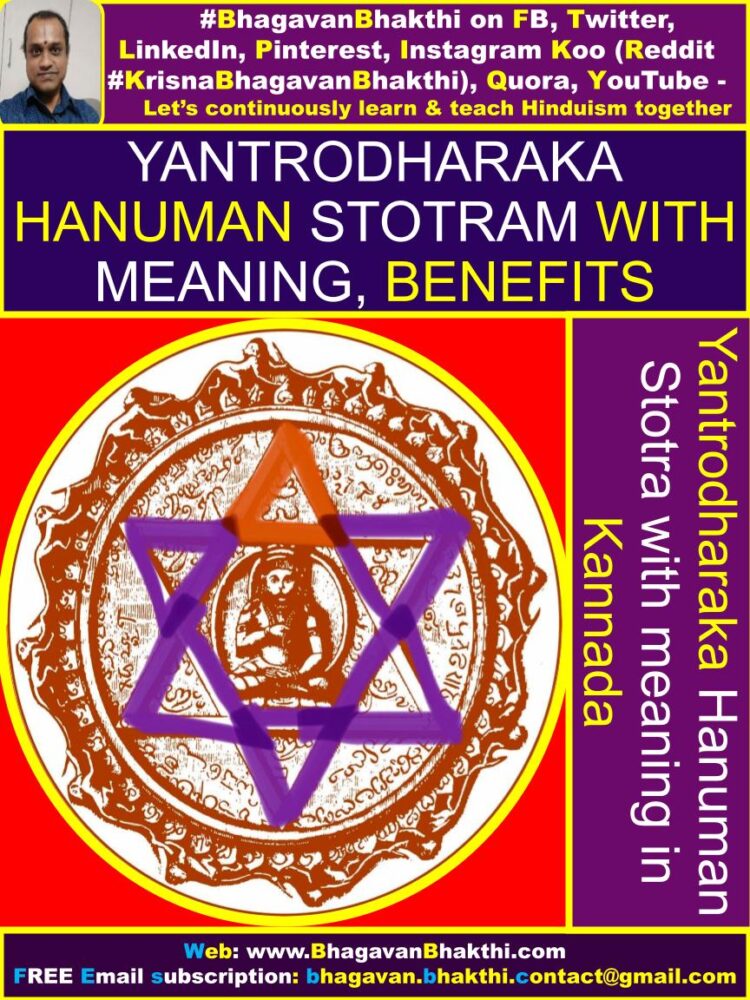
Hanuman Stotram (Stuti, Sloka) Yantrodharaka Hanuman Stotra (yantrōdhāraka hanumān sṭotraṁ) with meaning in English is as given below:
namāmi dūtaṁ rāmasya sukhadaṁ ca suradrumam |
pīnavr̥tta mahābāhuṁ sarva śatr̥ nivāraṇaṁ ||1||
nānāratna samāyuktaṁ kuṇḍalādi virājitam |
sarvadābhīṣṭhadātarāṁ satāṁ vai dhr̥ḍhamāvahē ||2||
vāsinaṁ cakra tīrthasya dakṣiṇastha girausadā |
tuṅgāmbōdhi taraṅgasya vātēna pariśōbhitē ||3||
nānādēśagataiḥ sadbhiḥ sēvyamānaṁ nr̥pōttamaiḥ |
dhūpadīpādi naivēdaiḥ pan̄cakhādyaiścaśaktitaḥ ||4||
bhajāmi śrī hanūmataṁ hēmakānti samaprabham |
vyāsatīrtha yatīndrēṇa pūjitaṁ praṇidhānataḥ ||5||
trivāraṁ yaḥ paṭhēnnityaṁ stōtraṁ bhaktyā dvijōttamaḥ |
vān̄chitaṁ labhatē bhīṣṭaṁ ṣaṇmāsābhyantarē khalu ||6||
putrārthi labhatē putrān yaśārthi labhatē yaśaḥ |
vidyārthi labhatē vidyāṁ dhanārthi labhatē dhanaṁ ||7||
sarvathā māstu sandēhō hariḥ sākṣī jagatpatiḥ |
yaḥkarōtyatra sandēhaṁ sayāti narakaṁ dhr̥vam || 8||
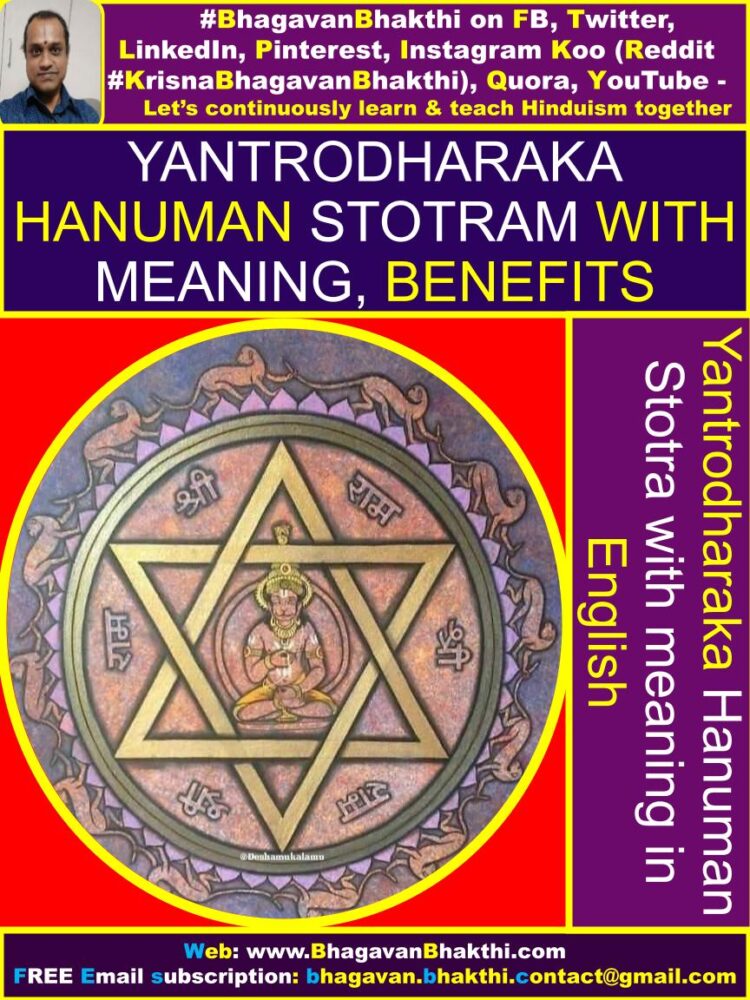
Meaning : Sloka 1 – I bow to you, O Lord Hanuman, you please Lord Sri Rama, the wish-fulfilling tree to the demons (Suras). Lord Hanuman have long hands which are gentle and slender. You are the destroyer of all the enemies. I bow to you.
Meaning : Sloka 2 – You are the one who is looking resplendent with the Kundalas (earrings). Those Kundalas (earning) are studded with various gems. You fulfill all the wishes of your devotees. You are steadfast in battlefield. I bow to you.
Meaning : Sloka 3 – O Lord Hanuman, you reside on the hill that is present south to the Chakra Tirtha. This hill looks magnificent with the winds that come flowing over the river Tunga.
Meaning : Sloka 4 – Even the best Kings and the people of various countries serve you. You are served with ritualistic practices of Dhupam (incense),
deepam (light) and naivedyam (divine food), and by pancha-khadya offerings (sweet made up of five ingredients namely dried dates, coconut, khas khas (poppy) seeds, raisins, and rock candy.
Meaning : Sloka 5 – You shine like gold and I pray to Lord Hanuman. You are worshipped by ‘Sri Vyasatirtha Yati’. I bow to you Lord Hanuman.
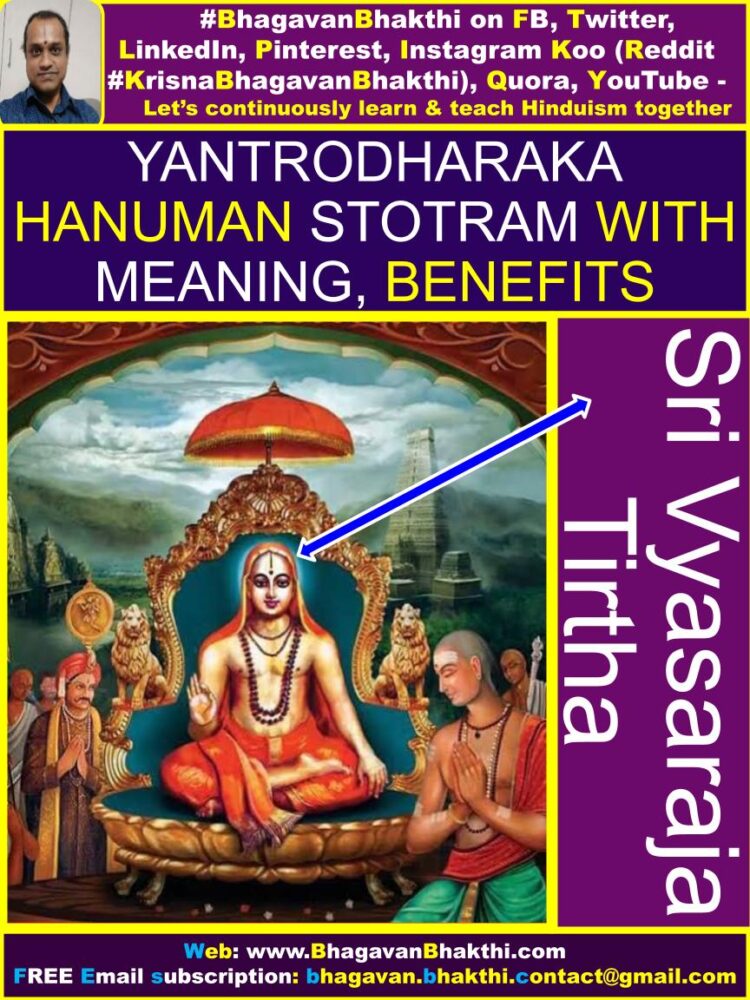
Meaning : Sloka 6 – Devotees who recite this stotra (stuti, hymn) thrice in a week become ultimate beings. And fulfills all desires within six months.
Meaning : Sloka 7 – A chanter (reciter) who seeks a child will attain progeny. You want glory, his/her glory is given with fame. Those who seek knowledge will get knowledge. And he/she who seeks wealth gets wealth.
Meaning : Sloka 8 – Never doubt the Eternal Truth as Lord Sri Vishnu is the witness of all and He is the Father of the Universe. And whoever doubts this eternal truth, he will surely go to hell (implying that non- devotees will never understand the ultimate truth).
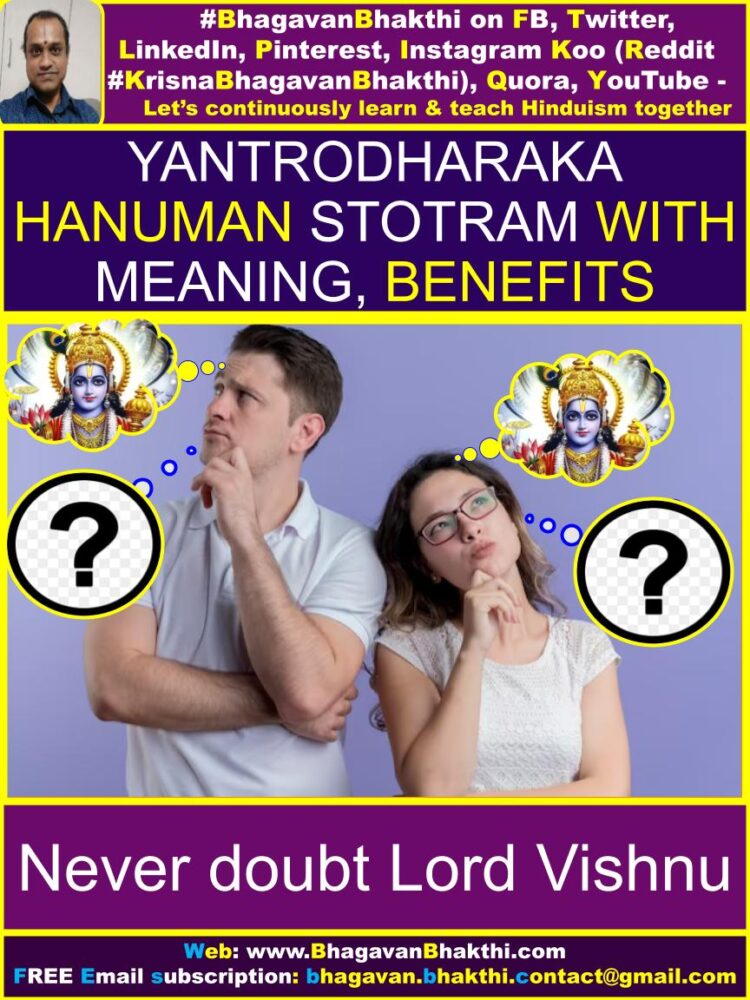
Thus the Yantradhara Hanuman Stotra composed by Sri Vyasaraja Yati (Vyasaraja, Chandrikacharya) is completed.
Benefits of chanting (reciting) “Yantrodharaka Hanuman Stotram” is as given below:
1. A chanter (reciter) of Yantrodharaka Hanuman Stotram who seeks a child will attain progeny.
2. A chanter (reciter) of Yantrodharaka Hanuman Stotram who wants glory in his/her life will get and attain the glory and fame.
3. A chanter (reciter) of Yantrodharaka Hanuman Stotram who wants both material and spiritual knowledge will gain the same as per his/her wish.
4. A chanter (reciter) of Yantrodharaka Hanuman Stotram who needs wealth in his/her life will get wealth as per his/her wishes.
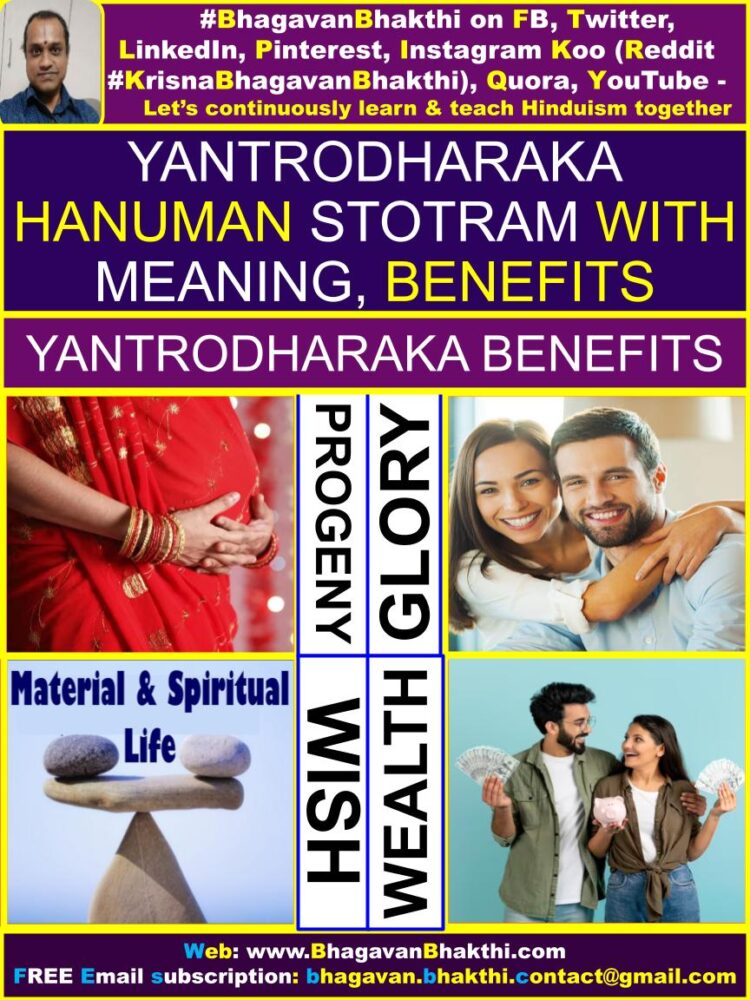
History and the significance of Yantrodharaka Hanuman Temple and Stotram (Legend of Yantrodharaka Hanuman temple) is as given below:
According to the theory of Sri Madhvacharya Ji (Madhva Siddhanta), Lord Hanumanta (Hanuman) is an avatar of Lord Sri Vayu Deva (Devaru). He is the one who protects the entire universe only after the Supreme Lord Sri Vishnu and Goddess Sri Lakshmi Devi.
The main and famous slogan of the ‘Madhva Parampara’ is ‘Hari Sarvottama and Vayu Jivottama’. This means that Lord Sri Vishnu is supreme in the entire universe and Vayudeva Jivottamaru means as supreme in all jiva (beings) and Jadas (inanimate objects).
Lord Hanumanta (Hanuman) is the first incarnation of Lord Sri Vayudeva (Vayudevaru) in the Treta Yuga. Madhvas believe that Lord Hanuman is the next greatest deity after Lord Sri Vishnu and Goddess Lakshmi.
Among all the Hanuman temples in India, Sri Yantrodharaka Hanuman Temple holds special significance and importance. Yantrodharaka Hanuman Temple is a Hindu temple dedicated to Lord Hanuman, located on a hilltop on the banks of the Tungabhadra River in Hampi, Karnataka, India.

This temple is also known as Pranadeva (Pranadevara Gudi / Devasthana) temple. Kodandarama temple dedicated to the Supreme Lord Sri Rama near Hanuman temple is a testimony to the union of Lord Sri Rama and Hanuman (As per Ramayana).
Sri Vyasaraja Tirtha (Teertharu) (Vyasarayaru) used to meditate daily on the banks of the river Tungabhadra. One day, while he was meditating he visualized an image of Lord Hanuman. It happened only at that particular place and nowhere else.
So next time, Sri Vyasaraja Tirtha (Tirtharu) painted (drew) that image of Lord Hanuman on the rock. To his surprise, a monkey came alive from the rock and jumped off the rock and his drawing disappeared. This happened continuously for 12 times.
Every time a monkey comes alive, jumps out and his drawing and was disappearing. At last Sri Vyasaraja Tirtha (Tirtharu) drew a Yantra around the image to prevent the monkey from going out of the rock.
Sri Vyasaraja Tirtha (Theetharu) confined Lord Hanuman inside the Yantra (middle). Here Lord Hanuman is in a sitting posture inside the Yantra. This is that divine and auspicious place where Sri Vyasaraja Tirtha (Tirtharu) composed the famous Hanuman hymn “Yantrodharaka Hanuman Stotra”.
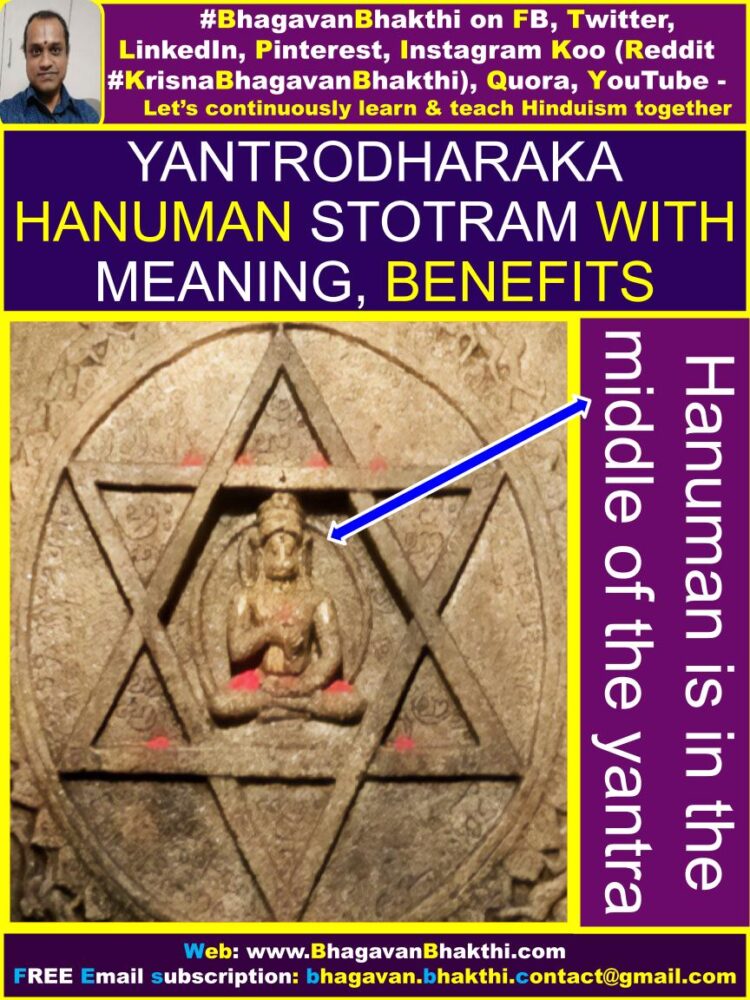
Location of Yantrodharaka Hanuman Temple : This temple is located in Hampi in the Indian state of Karnataka. You can find this temple on a small hill behind Kodandarama temple.
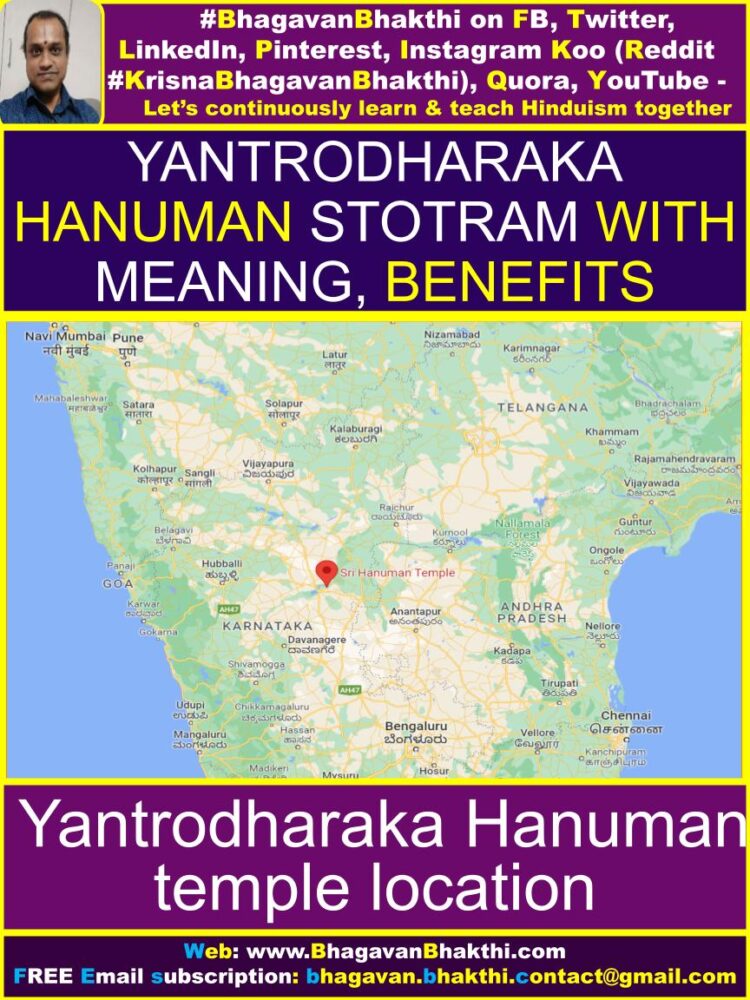
More information : The “Yantrodharaka Hanuman temple” was built by the Vijayanagara Emperor Tammaraya. The diety of Lord Hanuman is painted (drawn) on a granite stone. At the center of the Srichakra, known as Yantra, is Lord Hanuman seated in Padmasana posture.
Lord Hanuman’s right hand is seen holding the ‘Vyakhyana Mudra’ (Teaching form) and his left hand the ‘Dhyana Mudra’ (Meditative form). Lord Hanuman is seen wearing Kirita (Crown), and other usual ornaments on his body.
On the Srichakra Yantra, there are carvings of 12 monkeys holding each other’s tails, representing Sri Vyasaraja’s 12-day prayer. The composer of this stotra is the Guru of Sri Vadiraja Tirtha (Tirtharu), Sri Vijayindra Tirtha (Tirtharu), Sri Purandara Dasa (Dasaru), Sri Kanaka Dasa (Dasaru) and others.
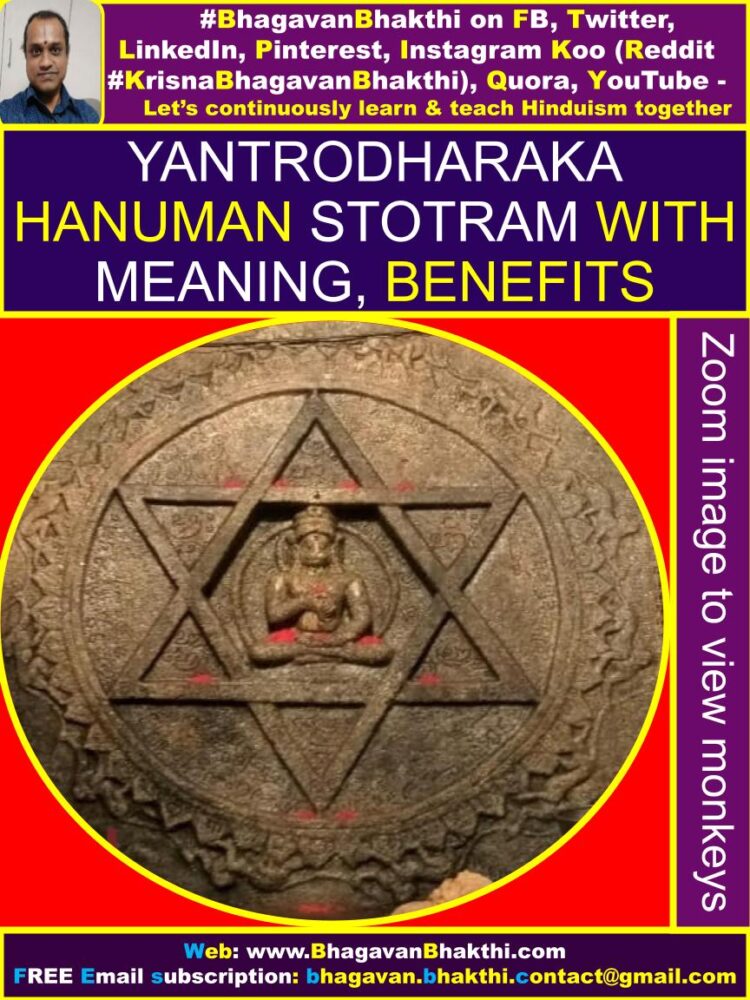
More information will be added to this on regular basis, please visit after some time to know more information.
To watch videos on #Hinduism #Sanskrit language, SUBSCRIBE to my YouTube channel from this link: #BhagavanBhakthi YouTube channel
To know more about “Sri Raghavendra Swamy facts“, please click this link: Sri Raghavendra Swamy facts
To know about “What are the different avatars of Prahlada Maharaja (Raghavendra Swamy)“, click this link: What are the different avatars of Prahlada Maharaja (Raghavendra Swamy)
Continue reading about “Hanuman information, facts, significance, importance” from here : Hanuman posts in Bhagavan Bhakthi
Continue reading about “Stotrams (Stutis, Slokas) of different Gods” from here : Stotrams (Stutis, Slokas) of different Gods
Dear friends, if you need any clarifications about this post, kindly let me know, I will definitely try to answer all of them.
Also your one LIKE, one COMMENT, One Share, one SUBSCRIPTION is highly important.
This will help to know the quality of this content and also it will be helpful to know if any improvements is required for the content.
If you feel this content is useful to you and has helped you to improve your knowledge, kindly share this with your well-wishers.
Because “SHARING MEANS CARING”.
To receive FREE EMAIL SUBSCRIPTION about #BhagavanBhakthi, you can send an email to [email protected] from your email ID.
NAMASTE!
Sri Gurubhyo Namaha
Sri Krishnaaya Namaha
Sri Krishnaarpanamastu
pranaam,
which three days is supposed to recite this stotra.
Jai sree ram
Dear Sudhee Ji,
It is suggested to recite this stotra everyday in the morning after sunrise.
Shubhamastu!
Namaste,
I want to know the letters and words inscribed on the yantra and what does it mean.
Thanks.Excellent information.
In the outer Circle , between the circle and 12 monkeys holding tail of each next, there are 50 alphabets. These alphabets does not seems to be that of kannada , as verified with all versions of kannada lipi through ages as published by Karnataka Ithihaasa Academy including the Viajanagar Era Lipi given there. It is neither Sanskrit or Devanagari lipi.
Is there any information on which Lipi & language these Alpahnbets belong to?. One researcher says ,Sauraseni Prakrit, is that a possibility ?. Why Viajaya Theertha chose those alphabets than Sankrit/Devnagiri/Kannada/Telugu which were Kingdoms languages.?
May be the Poojari there or the Mutt or Samasthanam at Anengondi may have some clues?
Sir, Can you do some research and throw light ?
Thanks so much
Nageswaran